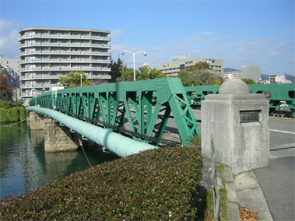
Date completed
November 1897
Date collapsed
April 1988
Date rebuilt
1949
Constructor Hiroshima City- Nekoya Bridge
- Steel plate truss bridge
- Damage from the A-bomb and collapse due to the Makurazaki Typhoon
- Reconstruction
The bridge was located 250m away from the center of the explosion center. The strong blast from the explosion caused the bridge beams to move and break off the piers which made the bridge partially collapse. Water pipes also broke off from the bridge and water supply was stopped. Immediately afterwards the bridge was urgently repaired by laying out boards but through the Makurazaki Typhoon in September it finally collapsed and only the piers remained.
The bridge was rebuilt as a solid steel truss bridge in 1897. This steel bridge was the newest model at that time. It connected Nakajima-Honmachi, Hiroshima's number one shopping and amusement district and the business area Sakai-machi-suji and became a new famous spot in Hiroshima.
The bridge was located 250m away from the center of the explosion center. The strong blast from the explosion caused the bridge beams to move and break off the piers which made the bridge partially collapse. Water pipes also broke off from the bridge and water supply was stopped. Immediately afterwards the bridge was urgently repaired by laying out boards but through the Makurazaki Typhoon in September it finally collapsed and only the piers remained.
The bridge was rebuilt in 1949 with the remaining piers by reusing steel materials from the Hikari Navy Arsenal in Hikari City (Yamaguchi Prefecture).